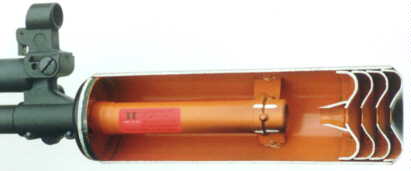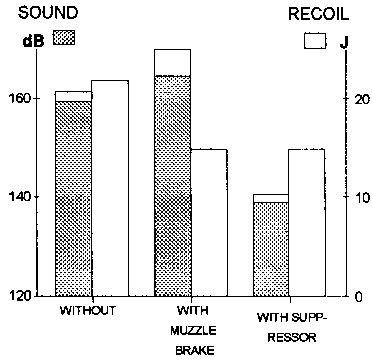Sorry Aliwa. Hate to do it to you, but in being right, you are also a bit wrong. Rocket thrust is nothing more than recoil. Generaly at quite a bit lower pressure than a freshly uncorked high powered rifle bore, but it's still an unbalanced reaction to pressure, and it's momentum is equal to the mass and velocity of the ejecta. And it is the same principle upon which muzzle brakes and thrust reversers work.
As I recall, the limiting velocity for the escaping gas from a rifle bore is in the neighborhood of 6000fps. For some reason I want to say that refered to a 30 cal, bore, but I'm not positive. The limit on bullet velocity seems to be in the 5000-5200fps range, so a bit faster than that would be normal.
We could take the following example and micro-engineer the dog squat out of it, but it'd get way too complex. So I'm going to address it in fairly large generalities.
Let's assume that we have a 200 grain bullet, in front of 50 grains of a powder that launches it at 3000 fps from a 26" barrel. (This is just to set up the math - the values can be changed later to fit any particular load you have)
Bullet data
200*3000= 600000 grain-ft/sec
Gas Data
50*6000=300000 grain-ft/sec
So a full 33.3% of the recoil is due to the ejected gas
(granted not all of that portion is felt at the exact same time, but we'll get to that - before the bullet leaves the barrel this portion is "only"
50*1500=75000 grain-ft/sec or 11% of the total recoil impulse)
We've been using the assumption that the average velocity in the barrel is the average between the intial velocity and the muzzle velocity, or
(3000-0)/2 = 1500fps
I know that this is way conservative on the slow side because the bullet is traveling much faster than that by the time it gets to the 13" mark. But that fact causes the "time in barrel" number to be a lot smaller and that causes a few things to show up that really scare some folks, so we'll stay with the conservative figure for now.

At the point where the 200gr bullet has gone 26", and the 50 gr or powder gas has gone 13" (some has gone 26" some hasn't moved, and there is uniform pressure through the bore) The rifle has generated some 670000 grain-ft/sec of...well data at this point.
The cumbersome problem of dealing in feet and inches here is the problem of getting grains and pounds into a unit of mass. The Imperial unit of mass is the Slug - and it is the unit ones need to use (unless you like flip-flopping to metric and back for the conversions - which is just as bad)
There are 7000grains/lb, and 32lbs/Slug, (224000 grains/slug)
and a Slug-ft/sec/sec is a pound force. (grains/224000)
* 32ft/sec/sec = pounds force
Some folks may notice that there aren't enough "seconds" factors to come up with pounds force yet...And we haven't. We need a figure for the acceleration that got us to 3000fps - which is where the "average velocity" come in.
If our "average velocity" was 1500fps, and our barrel is 26" long - our time in barrel was 0.001444 Seconds.
So our momentum is (670000 grain-ft/sec)/0.001444 seconds
(670000/224000)Slug-ft/sec/0.01444sec.
or 2086.26 (.259248 rounded) pounds of force - double checked.
Some will D A M N that's a lot...Yes it is. However look at how far that has moved our (let's say 9 pound) rifle in that time.
F=MA or A=2086.26/(9/32) (It's that mass thing again)
A=7417.8 Ft/sec/sec (232 Gs or there abouts - and you wondered why scopes slipped)
Distance=Velocity*time=1/2At^2
So 3708.9 *0.001444 *0.001444 =0.007738 feet
0r 0.093"
Up to this point it didn't make any difference if you had a brake or not, as the bullet has not uncorked the barrel.
Any questions?




